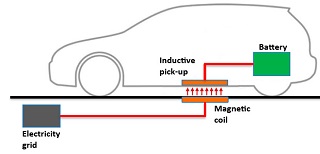Inductive Charging of Electric Vehicles Make a Great Deal of Sense in Certain Applications

Here’s a video on the subject from Oak Ridge National Laboratory, part of the (soon to be disemboweled) U.S. Department of Energy.

Here’s a video on the subject from Oak Ridge National Laboratory, part of the (soon to be disemboweled) U.S. Department of Energy.
That could be very efficient provided that the vehicle stops with sufficient accuracy.
Craig,
Yes indeed ! Inductive charging is the way to go !
Oddly enough, this simple and convenient technology has meat with resistance among a certain type of EV enthusiast who adopt a peculiar moralistic approach believing this method of charging as lazy.
We have been working with a South Korean corporation to develop a inductive charger (little like a robot carpet cleaner) that will automatically locate and charge vehicles within it’s detection and range.
Improving battery technology has minimized the disadvantages from irregular charging.
@Craig
Well yes and no.
Recharging of electric vehicles technology is more important than the electric motivation technologies themselves.
An enduring specification will look something like this:
1. High speed charging (up to 100 kmh) strip (under road surface).
2. Charging will be achieved very quickly and require no special considerations at all by the vehicle driver. Simply driving as normal over marked roadway that indicates in-road charging is available. Charging will be accomplished via a very high voltage isolated coupling of a “regulated coulomb accumulator” in the vehicle, and the target charging time should be for less than 1 second.
3. Automatic charging billing for the car owner of course.
This is a “minimum standard” enduring technology specification in my estimation, and this sort of stuff is already being devised and tested (small scale devices) within high power research labs all over the place.
The critical engineering development considerations are of course: (1) speed of charge, and (2) quantity of charge deliverable.
The old notion of the pull into “charging station” pe se was dead and buried the day the first one was installed in Japan many years ago (or before that actually).
I recall having this exact conversation with the Head Development Engineer for Mitsubishi Japan at Exhibition Eco-Asia 2008 Hong Kong where I was an exhibitor.
But we all know we have to start somewhere for the evolutionary product development path to spring from.
Lawrence Coomber
Lawrence,
You wrote, “Charging will be accomplished via a very high voltage isolated coupling of a “regulated coulomb accumulator” in the vehicle, and the target charging time should be for less than 1 second.”.
That is a bit too optimistic. If you calculate how much current would be required to charge the car in one second, I think you would find that it would require thousands of amperes. Charging while moving is also a bit doubtful. However, I do think that more places to charge coupled with increased battery capacity would increase the demand for EVs.
If I had a currently available EV, I could probably drive for a few months without exceeding the range, even if I charged only at home. However, I wouldn’t even be able to take the occasional long trip. Perhaps for some of us, a trailer-mounted generator would be an acceptable solution. It could be left in the garage most of the time and attached only when longer trips were to be made. Or perhaps, if EVs were designed for it, a trailer-mounted generator could be rented when necessary.
Craig is familiar with one company working on this idea near me, Momentum Dynamics. Another company working on this is HEVO power in Brooklyn.
http://www.momentumdynamics.com/momentum-dynamics.html
http://www.hevopower.com/